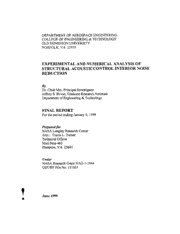
NASA Technical Reports Server (NTRS) 19990052758: Experimental and Numerical Analysis of Structural Acousticcontrol Interior Noise Reduction PDF
Preview NASA Technical Reports Server (NTRS) 19990052758: Experimental and Numerical Analysis of Structural Acousticcontrol Interior Noise Reduction
DEPARTMENT OF AEROSPACE ENGINEERING COLLEGE OF ENGINEERING & TECHNOLOGY OLD DOMINION UNIVERSITY NORFOLK, VA 23529 EXPERIMENTAL AND NUMERICAL ANALYSIS OF STRUCTURAL ACOUSTICCONTROL INTERIOR NOISE REDUCTION Dr. Chuh Mei, Principal Investigator Jeffrey S. Bevan, Graduate Research Assistant Department of Engineering & Technology FINAL REPORT For the period ending January 9, 1999 Prepared for NASA Langley Research Center Attn.: Travis L. Turner Technical Officer Mail Stop 463 Hampton, VA 23681 Under NASA Research Grant NAG-1-1684 ODURF File No. 151651 June1999 FORWARD The research results contained in this technical report were performed under the NASA grant NAG-l-1684 entitled "Experimental and Numerical Structural Acoustic Control for Interior Noise Reduction". The report is based essentially on partial progress of the Ph. D. dissertation prepared by Jeffrey S. Bevan under direct guidance of Dr. Chuh Mei. The document presents a finite element formulation and control of sound radiated from cylindrical panels embedded with piezoceramic actuators. The extended MIN6 shallow shell element is fully electrical-structural coupled. A piezoelectric modal actuator participation (PMAP) is defined which indicates the actuator performance to each of the offending modes. Genetic algorithm is also employed to validate the sensor and actuator locations determined by the PMAP criteria. The work was conducted at the Department of Aerospace Engineering, Old Dominion University. Mr. Travis L. Turner, Structural Acoustics Branch, NASA Langley Research Center is the technical monitor. The research is continued under the new grant NAG-1-2141. TABLE OF CONTENTS Section page 1. Foreword .................................................................................................................. ii 2. Shallow Shell Finite Element Formulation .............................................................. 1 3. Element Displacement Functions ............................................................................ 1 4. Strain-Displacement Relations ................................................................................. 5 5. Constitutive Relations .............................................................................................. 6 6. Force and Moment Resultant ................................................................................... 7 7. Equations of Motion ................................................................................................ 8 8. Modal Formulation .................................................................................................. 16 9. Development of Actuator Location Optimization Process ...................................... 17 I0. Coupled Acoustics using Radiation Filters .............................................................. 18 11. Control Strategy ....................................................................................................... 22 12. Genetic Algorithm ................................................................................................... 25 13. References ................................................................................................................ 26 iii 1. Shallow Shell Finite Element Formulation The three-node shallow shell element presented is an extension of the MIN6 developed by Tessler I. A brief description of the element attributes includes 3-node shallow curved shell triangle with fifteen nodal degrees-of-freedom (dof). The element employs C° anisoparametric interpolation to account for both membrane and transverse nodal displacement. The membrane and transverse displacement each utilize unique interpolation polynomials, which offer distinctly different polynomial degrees as introduced by Tessler 2. The transverse displacement employs a complete quadratic polynomial, while the bending rotations utilizes a linear interpolation scheme. The MIN6 formulation consists of a Marguerre shallow shell membrane strain consistent with the Reissner-Mindlin theory which includes transverse shear effects. Static condensation eliminates the extra nodes required to facilitate the complete quadratic polynomials while maintaining the minimum specified number of nodal dof. By formulating a co-rotational highly nonlinear solution, Barut 3 et al exhibits the versatility of the MIN6 shallow shell element. This research further expands the MIN6 capability by including anisotropic piezoceramic materials in conjunction with unsymetric laminated composite resulting in a fully electrical-structural coupled shallow shell finite element formulation. 2. Element Displacement Functions Displacement field components ux, uy, and u,,, consistent with Mindlin theory, are described as zt._= u(x,y,t) + gOv(x,y,t ) zt_ = v(x,y,t) + _0_ (x,y,t) (2.1) u,,= w(x,y,t) where u, v, w represent the mid-surface membrane and transverse displacements; bending rotations of the normal about the x and y axes are given by Oxand Oyrespectively. The element coordinate system is defined as positive x along the side between nodes 1-2 as shown in Figure 1. The arbitrary shallow shell shape is described by ho(ir,y) and related to the z-axis as _ = z-h,(x,y) w,z y,v ×, 1.1 2 Figure 1MIN6 Geometric description
